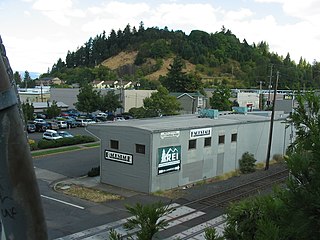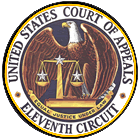
Mojave National Preserve is a United States National Preserve located in the Mojave Desert of San Bernardino County, California, US, between Interstate 15 and Interstate 40. The preserve was established October 31, 1994, with the enactment of the California Desert Protection Act by the United States Congress, which also established Joshua Tree National Park and Death Valley National Park as National Parks. Previously, some lands contained within the Preserve were the East Mojave National Scenic Area, under the jurisdiction of the Bureau of Land Management. At 1,542,776 acres (6,243 km2), within the contiguous United States it is the third largest unit of the National Park System and the first largest National Preserve. The preserve was created within the Pacific West Region of the National Park Service and remains within that jurisdiction today.
Near v. Minnesota, 283 U.S. 697 (1931), was a landmark decision of the US Supreme Court under which prior restraint on publication was found to violate freedom of the press as protected under the First Amendment. This principle was applied to free speech generally in subsequent jurisprudence. The Court ruled that a Minnesota law that targeted publishers of "malicious" or "scandalous" newspapers violated the First Amendment to the United States Constitution. Legal scholar and columnist Anthony Lewis called Near the Court's "first great press case".

Skinner Butte is a prominent hill on the north edge of downtown Eugene, Oregon, near the Willamette River. A local landmark, it honors city founder Eugene Skinner and is the site of the municipal Skinner Butte Park. During the early 1920s, the city's Ku Klux Klan members etched the letters "KKK" into the side of the butte and installed a cross near the top. Local Klan members were said to have burned the cross during meetings. The letters were removed and replaced with the letter "O" in the late 1920s. The cross was replaced several times since the Klan first erected it. However, the cross wasn't permanently removed until 1997. Eugene grew to be a recognized national stronghold for the KKK through the 1950s.

Mount Davidson is the highest natural point in San Francisco, California, with an elevation of 928 feet (283 m). It is located near the geographical center of the city, south of Twin Peaks and Portola Drive and to the west of Diamond Heights and Glen Park. It dominates the southeastern view from most of Portola Drive. It is one of San Francisco's many hills and one of its original "Seven Hills".

Glassroth v. Moore, 335 F.3d 1282, and its companion case Maddox and Howard v. Moore, 229 F. Supp. 2d 1290, is a decision from the United States Court of Appeals for the Eleventh Circuit that held a 2+1⁄2 ton granite monument of the Ten Commandments placed in the rotunda of the Heflin-Torbert Judicial Building in Montgomery, Alabama by then-Alabama Supreme Court Chief Justice Roy Moore was a violation of the Establishment Clause of the First Amendment.
County of Allegheny v. American Civil Liberties Union, 492 U.S. 573 (1989), was a United States Supreme Court case in which the Court considered the constitutionality of two recurring Christmas and Hanukkah holiday displays located on public property in downtown Pittsburgh. The first, a nativity scene (crèche), was placed on the grand staircase of the Allegheny County Courthouse. The second of the holiday display in question was an 18-foot (5.5 m) public Hanukkah menorah, which was placed just outside the City-County Building next to the city's 45-foot (14 m) decorated Christmas tree and a sign saluting liberty. The legality of the Christmas tree display was not considered in this case.
Public Employees for Environmental Responsibility (PEER) is a 501(c)(3) non-profit, environmental protection organization of local, state, and national government natural resource and environmental professionals. PEER serves as a resource to potential government whistleblowers, allowing them to anonymously expose environmental wrongdoings and assisting them in redressing agency retaliation.
Sáenz v. Roe, 526 U.S. 489 (1999), was a landmark case in which the Supreme Court of the United States discussed whether there is a constitutional right to travel from one state to another. The case was a reaffirmation of the principle that citizens select states and not the other way round.

The Mount Soledad Cross is a prominent landmark located on top of Mount Soledad in the La Jolla neighborhood of the city of San Diego, California. The present structure was erected in 1954; it is the third Christian cross in that location, the first having been put up in 1913. Architect Donald Campbell designed the present cross in prestressed concrete. It is 29 feet (8.8 m) tall with a 12-foot (3.7 m) arm spread. It is the centerpiece of the Mt. Soledad National Veterans Memorial.

Mount Rubidoux is a mountain just west of downtown in the city of Riverside, California, United States, that has been designated a city park and landmark. The mountain was once a popular Southern California tourist destination and is still the site of the oldest outdoor non-denominational Easter Sunrise service in the United States. Many historic markers and memorials have been placed on the mountain, the most prominent being the cross at the summit dedicated to Father Junípero Serra. A majority of Mt. Rubidoux is owned by the City of Riverside, while 0.43 acres at the peak is owned by Rivers & Lands Conservancy after the cross attracted a potential lawsuit and the city decided to sell it at auction it to a private organization.

The Jewish War Veterans of the United States of America is an American Jewish veterans' organization created in 1896 by American Civil War veterans to raise awareness of contributions made by Jewish servicemembers. It has an estimated 15,000 members, ranging from World War II to current conflicts and active duty personnel. It is the oldest active national veterans' service organization in America.

The Mojave Memorial Cross, officially known as the White Cross World War I Memorial, is a cross formerly on public land in the Mojave desert in San Bernardino County, California that was at the center of the Salazar v. Buono legal case before the U.S. Supreme Court. The original cross was erected in 1934 to honor those killed in war.
Presbyterian Church v. Hull Church, 393 U.S. 440 (1969), was a United States Supreme Court case involving the secession of two local churches, including Hull Memorial Presbyterian Church, from the parent body Presbyterian Church in the United States because, they claimed, the Church had departed from its original doctrinal tenets. The Court ruled that the state could not pass judgment concerning religious doctrine or church law.
Lyng v. Northwest Indian Cemetery Protective Association, 485 U.S. 439 (1988), was a United States Supreme Court landmark case in which the Court ruled on the applicability of the Free Exercise Clause to the practice of religion on Native American sacred lands, specifically in the Chimney Rock area of the Six Rivers National Forest in California. This area, also known as the High Country, was used by the Yurok, Karuk, and Tolowa tribes as a religious site.
Monsanto Co. v. Geertson Seed Farms, 561 U.S. 139 (2010), is a United States Supreme Court case decided 7-1 in favor of Monsanto. The decision allowed Monsanto to sell genetically modified alfalfa seeds to farmers, and allowed farmers to plant them, grow crops, harvest them, and sell the crop into the food supply. The case came about because the use of the seeds was approved by regulatory authorities; the approval was challenged in district court by Geertson Seed Farms and other groups who were concerned that the genetically modified alfalfa would spread too easily, and the challengers won. Monsanto appealed the district court decision and lost, and appealed again to the Supreme Court, where Monsanto won, thus upholding the original approval and allowing the seeds to be sold.

The Peace Cross is a World War I memorial located in Bladensburg, Maryland. Standing 40 feet (12 m) in height, the large cross, is made of tan concrete with exposed pink granite aggregate; the arms of the cross are supported by unadorned concrete arches. Erected by 1925 in the memory of 49 local servicemen from Prince George's County who died during World War I, the base of the cross displays the words "valor," "endurance," "courage," and "devotion" as well as a bronze tablet listing the names of those lost in combat.

Executive Order 13769 was signed by U.S. President Donald Trump on January 27, 2017, and quickly became the subject of legal challenges in the federal courts of the United States. The order sought to restrict travel from seven Muslim majority countries: Iran, Iraq, Libya, Somalia, Sudan, Syria, and Yemen. The plaintiffs challenging the order argued that it contravened the United States Constitution, federal statutes, or both. On March 16, 2017, Executive Order 13769 was superseded by Executive Order 13780, which took legal objections into account and removed Iraq from affected countries. Then on September 24, 2017, Executive Order 13780 was superseded by Presidential Proclamation 9645 which is aimed at more permanently establishing travel restrictions on those countries except Sudan, while adding North Korea and Venezuela which had not previously been included.

Executive Order 13780, titled Protecting the Nation from Foreign Terrorist Entry into the United States, was an executive order signed by United States President Donald Trump on March 6, 2017. It placed a 90-day restriction on entry to the U.S. by nationals of Iran, Libya, Somalia, Sudan, Syria and Yemen, and barred entry for all refugees who did not possess either a visa or valid travel documents for 120 days. This executive order—sometimes called "Travel Ban 2.0"—revoked and replaced Executive Order 13769 issued on January 27, 2017.

The Serra Cross, sometimes also known as the Cross on the Hill or the Grant Park Cross, is a Christian cross on a hill known as "La Loma de la Cruz" in Ventura, California. The site is in Serra Cross Park, a one-acre parcel within the larger Grant Park that overlooks downtown Ventura, the Santa Barbara Channel, and Anacapa and Santa Cruz Islands.
American Legion v. American Humanist Association, 588 U.S. ___ (2019), was a United States Supreme Court case dealing with the separation of church and state related to maintaining the Peace Cross, a World War I memorial shaped after a Latin cross, on government-owned land, though initially built in 1925 with private funds on private lands. The case was a consolidation of two petitions to the court, that of The American Legion who built the cross, and of the Maryland-National Capital Park and Planning Commission who own the land and maintain the memorial. Both petitions challenged the Fourth Circuit's ruling that, regardless of the secular purpose the cross was built for in honoring the deceased soldiers, the cross emboldened a religious symbol and had ordered it altered or razed. The Supreme Court reversed the Fourth Circuit's ruling in a 7–2 decision, determining that since the Cross had stood for decades without controversy, it did not violate the Establishment Clause and could remain standing.












